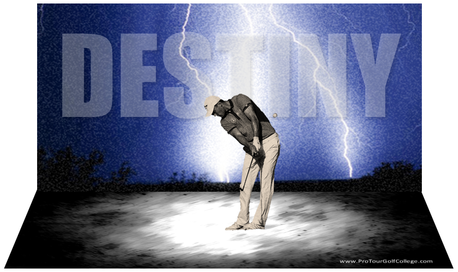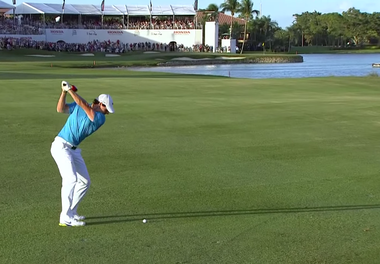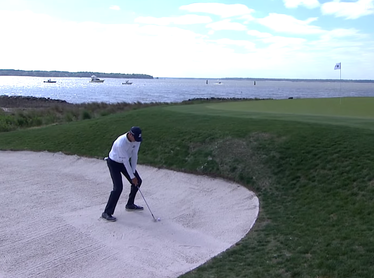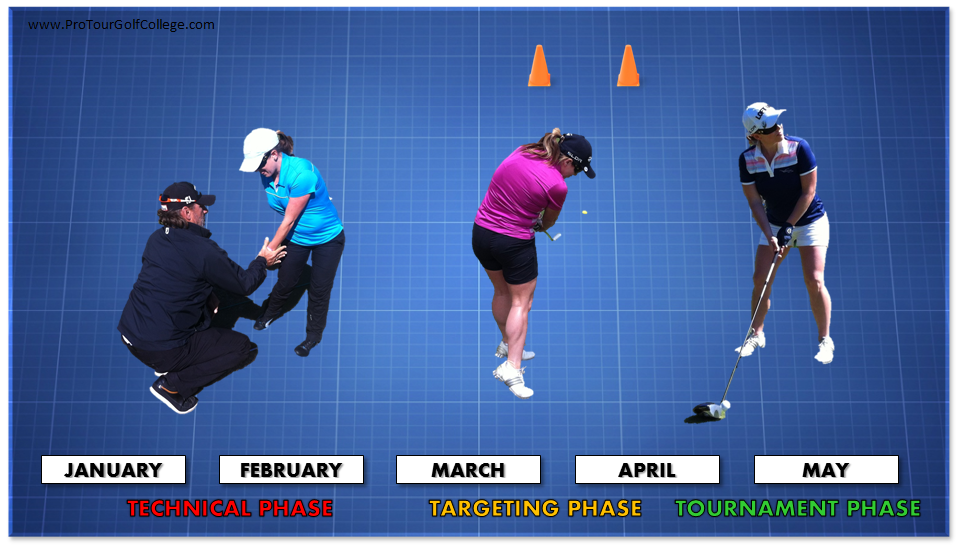|
Following on from last week's article where I discussed the first four letters in the D.E.S.T.I.N.Y. acrostic, here's the final three letters and the lessons to study and apply to your golf practice routines to help you have your best year ever in golf.  INTENSIFY YOUR PRACTICE TO PREPARE FOR THE PRESSURE My dictionary defines intensity as "a high degree of emotional excitement and great energy, strength and concentration." But we're not aiming just for intensity as it is described in the dictionary, we're aiming for an optimal state of intensity to pressure-proof our golf game. Optimal intensity is the ideal level of mental focus that you apply to hitting golf shots that helps you to perform your best on the golf course in tournaments. After all, is there any other reason to practice? When you think about it, you are not just developing skills to function correctly, you should also be developing your nervous system to hit golf shots confidently under pressure. At Pro Tour Golf College we share with our students that the goal of every practice session is to practice in their optimal performance state. This means that they learn to train right on the edge of the current ability because we want them to hit golf shots whilst they are in this ideal state of intensity so they can perform to the best of their ability with every golf stroke they make. Rating Arousal Levels From 1 to 10 We do this by simply rating the state of arousal they are in on a scale from one to ten with two being a low level of arousal, and eight being a high arousal level. We have found that the optimal state of intensity is around six to six and a half out of 10. In other words the level of intensity is around sixty percent of their maximum intensity level. Each golfer will experience these arousal levels differently; however the idea is to hit practice shots with your arousal level slightly higher than half way on the scale. One of the biggest challenges you are faced with when competing in tournaments is getting into an over-aroused emotional state, particularly under pressure, where you would rate as high as a nine on the scale. By developing your awareness of your arousal levels when you practice you can learn how to hit your shots in the optimal zone by teaching your nervous system to continually adapt to the challenges you face so that you can hit pressure shots successfully any-time-any-where. But how do you practice right on the edge of your golfing ability?  Match your skill level to the challenge level to practice in the optimal state Match your skill level to the challenge level to practice in the optimal state NEGOTIATE BETWEEN THE CHALLENGE AND YOUR SKILL LEVEL All golf practice is a negotiation between skill and challenge. The key to effective golf practice design is to practice right on the edge of your ability. To do this you need to understand that you are negotiating carefully between the challenges you set up for yourself when you practice and your current level of skill. The idea is to set up golf practice routines that challenge your golf skills by putting you under increased but manageable pressure. You see you’re attempting to train or condition your central nervous system (CNS) to gradually become more and more accustomed to dealing with increased pressure so that you’re more capable of producing important golf shots when you need to. To effective train your CNS design continually challenging practice routines. These routines are such that they put you and your golf skills under increased pressure so that you learn how to adapt gradually so you can execute your strokes competently under any type of pressure.  Your job is to practice and develop each golf skill to the level of unconscious competence, where you can execute golf skills without thinking about how to. This is the level of performance that you must aim for to hit golf shots confidently and competently when it matters. Every time you practice your golf skills you need to design routines that challenge your golf skill confidence level and take it right to the edge of the stressed out zone. The stressed out zone is the zone where your golf skills do not match the challenge level you have designed for yourself. The stressed out zone is a high mistake zone where you basically cannot pull the shot off you are attempting more than one or two times out of ten, or about 20 percent of the time. This stressed out zone is to be avoided because it can get you into an over aroused (frustrated or angry) state and away from the optimal performance zone. When you practice your golf skills your main objective is to almost match up your golf skill level to the challenge level you design (the negotiation). You do this by designing practice routines where the skill to challenge level success rate is from 40 to 60 percent. This will have you practicing in the optimal performance zone for developing tough golf skills that won’t break down under any type of pressure.  By looking at your year you can allocate time for technical and targeting practice By looking at your year you can allocate time for technical and targeting practice YEARLY PLANNING DRIVES TECHNICAL AND TARGETING PRACTICE The key to ongoing improvement of your golf skills is preparation, and specifically you look at a full year of golf and identifying the important tournaments you want to perform your best in develop a weekly golf plan to carefully manage your practice from week to week throughout the year to play you best when the important tournaments come around. An annual golf development plan is also known as a periodized plan essentially breaks your year down into smaller and more manageable phases of practice leading to an important event on your calendar. Surprisingly many advanced and elite golfers in our experience don’t have or use an annual golf development plan which makes little sense if you’re a serious competitive golfer who wants to continue to get better. It’s definitely worth learning some of the basics of how to design a simple plan that will give you an edge over golfers who don’t know how to plan their year, or don’t want to. We are going to focus on two elements in practice. So begin by dividing your golf skill development into two distinct categories. 1. A technical skill development phase 2. A targeting skill development phase To learn how to design a periodized golf plan here are the links to a detailed set of articles that will enable you to do so. http://www.protourgolfcollege.com/news-blog/how-to-design-your-annual-golf-training-and-performance-success-plan-part-1 http://www.protourgolfcollege.com/news-blog/how-to-design-your-annual-golf-training-and-performance-success-plan-part-2 http://www.protourgolfcollege.com/news-blog/how-to-design-your-annual-golf-training-and-performance-plan-part-3 Technical Skills Development (Practice drills, video analysis, training aids and lots of repetition) Technical skill development in long game and short game begins very early in the year before the main tournaments begin. The idea here is that the golfer and their instructor allocate enough lead time to improve the golfers weaker techniques with the goal of moving them to a level of unconscious competence. Keep in mind that this rarely happens for the majority of elite golfers we've observed because many are making the mistake of still working too much on their techniques by the time their major tournaments come around which means they are not nearly ready to perform at their best. This is very common and a recipe for disaster. You need at least eight to ten weeks of time allocated for technical skill development so you can effective transition from the technique phase into targeting phase. This means that a golfer will be in a technical development phase for all of January and February and half way through March before they transition into a targeting skills phase for the rest of March and all of April in preparation for an important tournament in May.  You have to be at the unconscious competence stage to play this shot You have to be at the unconscious competence stage to play this shot Targeting Skills Development (Targets, ball flight control, skill testing, rhythm and tempo) Once you have developed your golf skills through the technical phase you then need to make the transition to where your focus is more on controlling the behavior of the ball flight rather than controlling how you execute the stroke. So you go from a stroke control phase to a ball flight control phase. You are not thinking about how to execute your stroke now; you are hitting shots as accurately as you can to various targets. Golf shot-making in tournaments requires that you develop your ability to where you hit a relatively high percentage of golf shots into the fairways and onto the greens consistently without thinking how to. For example, the targeting performance threshold for a tournament professional is around 60 percent. This means that they must hit a minimum of 60 percent of fairways, or around 8 fairways out of 14, and no less than 60 percent of greens hit in regulation, or around 11 greens out of 18. To achieve a 60 percent standard means that six shots out of ten land inside your chosen target zones. Remember, when you set up your target zones in practice you are negotiating between the size of the targets and matching them to the level of your skill.  By tournament time you will be confident playing shots around the green By tournament time you will be confident playing shots around the green Around the greens you also need to establish target zones you can hit sets of golf balls into and then measure your results. As an elite golfer (handicap less than 5) the target zone for a chip or pitch shot will ideally have a diameter of 6 feet to challenge you. Study our Handicap / Skill Level to Target Size Matrix below to practice to the target zone size that is based on your current skill or handicap level. The targeting development phase is the golf skill sharpening phase where your refine ball behavior in terms of distance control and accuracy. This approach to developing your golf skills will help you to transfer your practice results into competitive results on the golf course. By now you will have a much better idea of what to incorporate into your golf practice routines to practice with definite purpose. The D.E.S.T.I.N.Y. approach to golf practice improvement will help you to practice with the right level of intensity by skillfully negotiating your skills against the challenges you design for yourself, this will improve your intensity of focus so you extract a lot more out of your practice sessions this year.
We wish you the very best using the D.E.S.T.I.N.Y. approach to golf improvement, and thanks for taking the time to read our articles . Lawrie Montague and David Milne - Pro Tour Golf College The Professional Golf Tour Training College Comments are closed.
|
Archives
June 2019
|
Proudly Supported By
Copyright © 2011 - 2018 Pro Tour Golf College
Website Managed By Golf Performance Media
All Rights Reserved
Website Managed By Golf Performance Media
All Rights Reserved





 RSS Feed
RSS Feed



